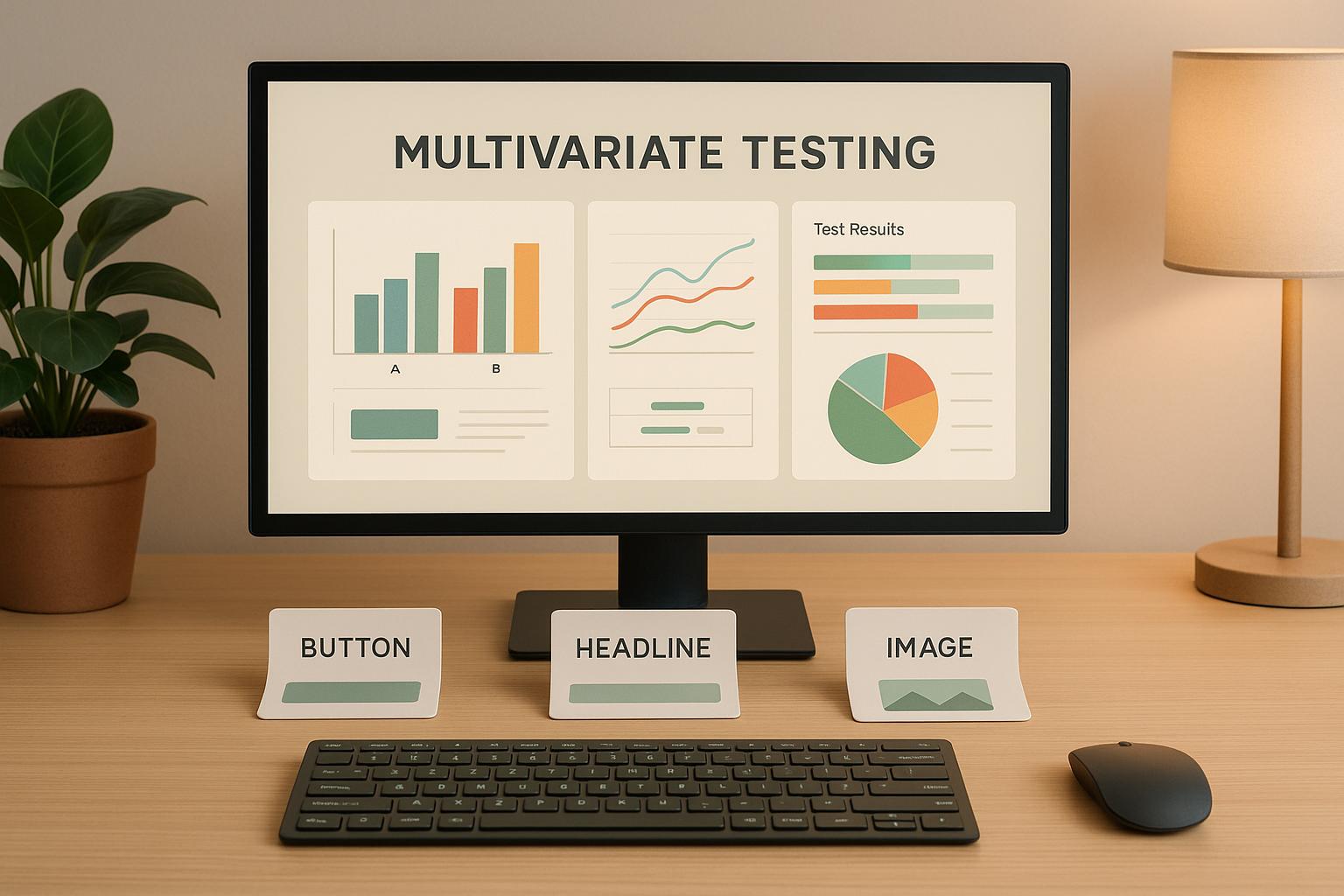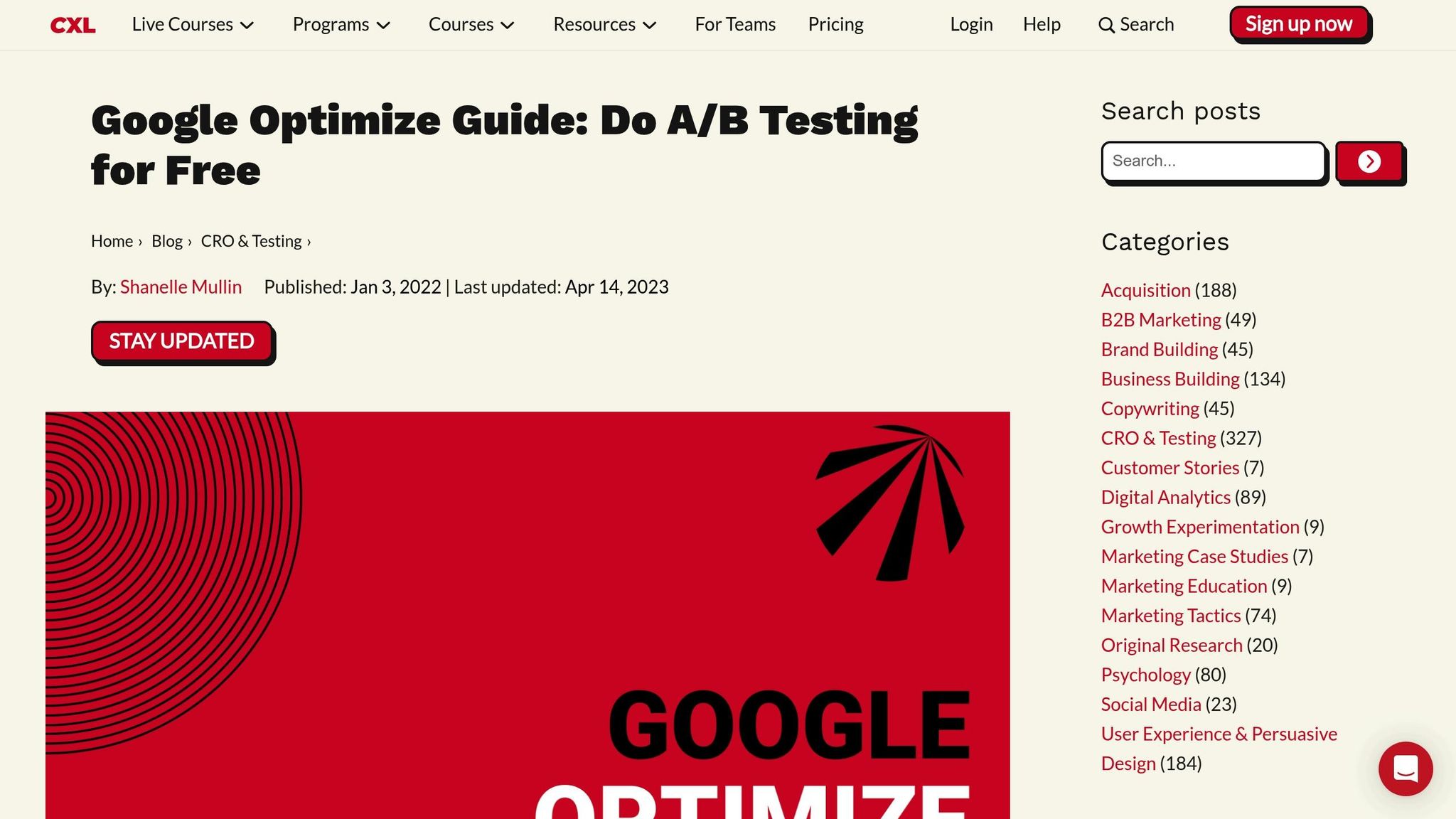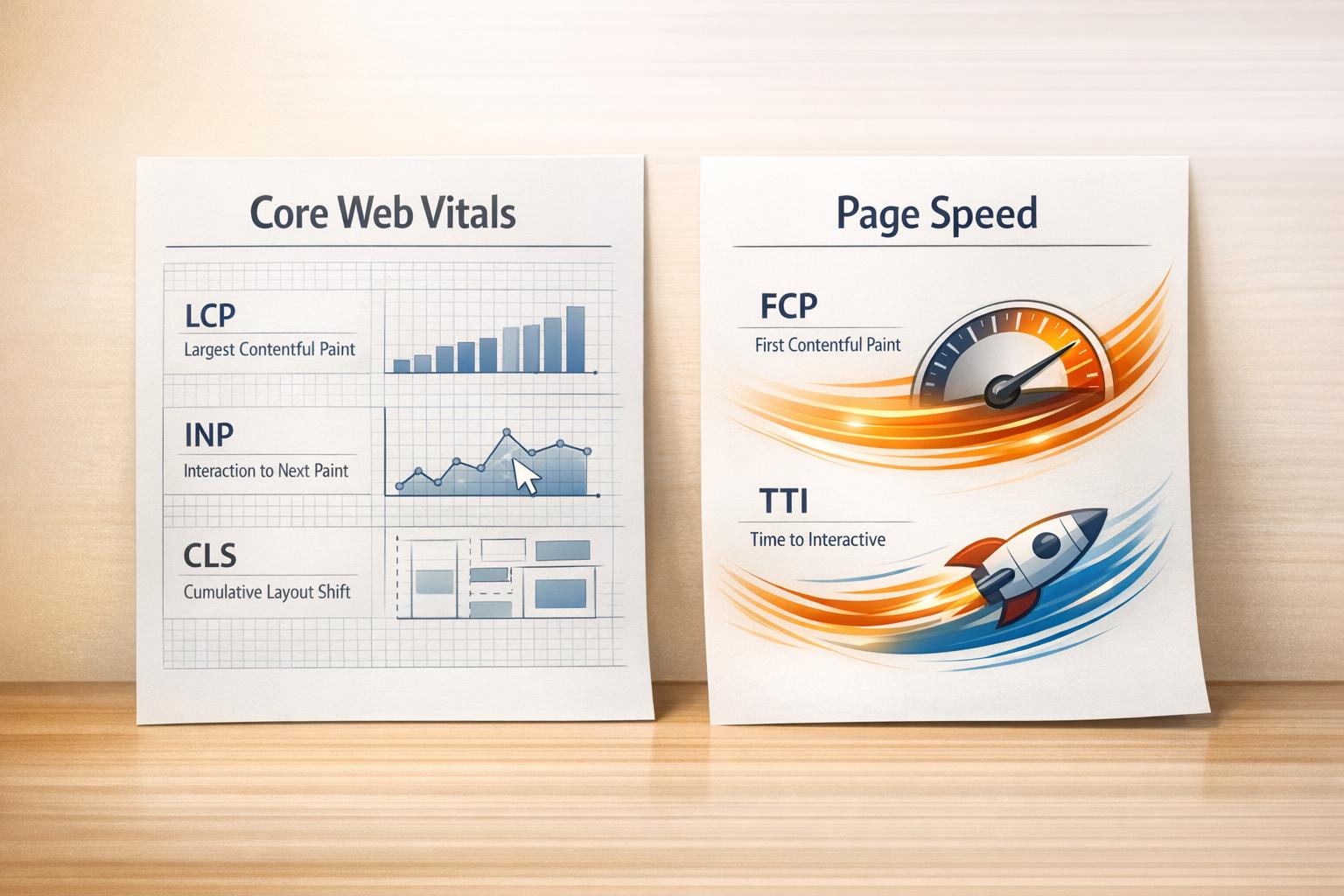

How to Use AI for Multivariate Testing

How to Use AI for Multivariate Testing
 22-07-2025 (Last modified: 22-07-2025)
22-07-2025 (Last modified: 22-07-2025)
Want to improve conversions without guesswork? AI-powered multivariate testing is your answer. Unlike A/B testing, which compares two options, multivariate testing evaluates multiple page elements – like headlines, CTAs, and images – simultaneously to find the best-performing combination. AI simplifies this process by automating test setups, tracking results in real time, and delivering actionable insights.
Key Takeaways:
- What It Is: Multivariate testing analyzes how changes to multiple elements work together to influence user behavior.
- Why Use AI: AI automates variation creation, monitors performance, and removes underperforming combinations, saving time and effort.
- Tools to Try: Platforms like PageTest.AI offer no-code solutions for easy setup and testing.
- Benefits: Companies like Ashley Furniture and SWISSGEAR have seen sales increases of 15% and 52%, respectively, through multivariate testing.
How to Get Started:
- Define clear goals and hypotheses.
- Choose key variables (e.g., headlines, CTAs) and create realistic variations.
- Ensure sufficient traffic for meaningful results.
- Use AI tools to set up, monitor, and analyze tests.
AI makes advanced testing accessible for businesses of all sizes, helping you optimize faster and with precision. Let’s break down how to make it work for you.
What is Multivariate Testing and How AI Helps
What is Multivariate Testing?
Multivariate testing is a method used to evaluate multiple changes at the same time, helping to uncover how different elements on a page interact with each other. This approach allows you to test combinations of elements like headlines, images, call-to-action buttons, and page layouts to understand their combined impact.
"Multivariate testing evaluates multiple changes simultaneously to understand how different elements interact."
- Metadata Team
What sets multivariate testing apart is its complexity and the depth of insights it provides. While A/B testing focuses on comparing two versions to identify the better-performing option, multivariate testing digs deeper by analyzing how various components work together. This makes it ideal for gaining a more detailed understanding of user interactions. However, because it divides traffic across multiple combinations, it requires a much larger audience to produce meaningful results.
"Multivariate testing can be useful to understand the impact that different parts of a user experience have on conversion – however conversion is defined in a specific context. We call this element contribution. This can be informative to do before a larger scale A/B test or a website redesign, so you can have a clearer understanding of how important certain elements are to success."
- Jake Sapirstein, Head of Strategy at LiftCentro
By identifying how individual elements contribute to the overall user experience, multivariate testing lays the groundwork for AI to simplify and optimize the process.
How AI Improves Multivariate Testing
AI takes the complexity out of multivariate testing by automating much of the process, making it faster and more efficient. Instead of manually tracking and analyzing countless combinations of elements, AI systems handle these tasks seamlessly. This means quicker results and more accurate insights.
With AI, creating variations becomes effortless. These systems can generate new images, text, or even code, enabling brands to test a wide range of ideas across entire conversion funnels – not just isolated pages – all within the same timeframe as traditional A/B tests. AI also monitors experiments in real time, removing underperforming variants and introducing new ones, ensuring continuous optimization. By integrating data from multiple sources, AI delivers a more nuanced analysis of user behavior and preferences.
Benefits of Using a No-Code AI Platform Like PageTest.AI

No-code platforms powered by AI, such as PageTest.AI, make multivariate testing accessible to everyone, regardless of technical expertise. These tools eliminate the need for coding, enabling marketers, business owners, and SEO specialists to set up and run tests through an intuitive interface.
"PageTest.ai is a completely no-code solution. You can set up and run A/B tests through a simple interface without any technical expertise. It’s perfect for users who aren’t developers (marketers, SEO specialists, business owners, etc.)."
- PageTest.ai
Using AI, these platforms save time by automatically generating multiple variations based on your goals and brand guidelines. Real-time analytics then pinpoint the best-performing elements, allowing for quick adjustments. Integrations with popular WordPress themes and page builders like Elementor, Gutenberg, and Divi make it easy to start testing immediately without needing a full website overhaul. Plus, with a free plan available, businesses of all sizes can experiment with advanced testing and scale up as needed.
How to Prepare for an AI-Powered Multivariate Test
Setting Clear Goals and Hypotheses
Before diving into testing, it’s essential to define your goals and hypotheses. These will guide your efforts and help you determine which elements to test and how to measure success.
"Successful experimentation begins by clearly defining goals."
Start by identifying a specific and measurable goal that ties directly to your business objectives or user experience metrics. Instead of vague targets like "improve the website", focus on tangible outcomes like increasing conversion rates, boosting engagement, or reducing checkout abandonment.
Your hypothesis should be structured to provide clear direction. For example: "Based on insights from heatmaps and other qualitative tools, I believe that placing the ‘Add to Cart’ button inside a colored box will lead to higher interaction and more conversions."
"A clearly defined A/B testing hypothesis is one of the most overlooked elements of a high-performing experimentation program. Establishing your hypothesis in advance offers benefits such as setting expectations, focusing on your goals, and helping you learn from the outcome, no matter the results." – Mike Fradkin, Director of Product Marketing at SiteSpect
Using the SMART framework – Specific, Measurable, Achievable, Relevant, and Time-bound – can help ensure your objectives are well-defined. This approach also enables your AI-powered testing platform to track performance effectively and deliver insights within your desired timeframe.
Here’s a real-world example: Hyundai.io wanted to increase test drive requests and brochure downloads on their car model pages. They hypothesized that adding SEO-friendly text, extra CTA buttons, and larger car images would improve conversions. After testing eight combinations, they saw a 62% increase in conversion rates for test drive requests and brochure downloads, and a 208% boost in click-through rates.
Once your goals are set, identify which variables have the most direct impact on your conversion path.
Choosing Key Variables and Variations
The success of your test hinges on selecting the right elements to experiment with. Focus on variables that directly influence user actions – those that visitors must interact with to complete your desired goal.
Some impactful variables include:
- Headlines
- Calls-to-action (CTAs)
- Images
- Product descriptions
- Pricing displays
- Page layouts
For each variable, design 3–5 realistic variations. Avoid extreme changes that wouldn’t align with your business model or user expectations.
"It’s important to understand that multi-variate doesn’t mean multiple VARIATIONS. You can have one variation with multiple variables, or multiple variations with single variables, or a mishmash of them." – Shiva Manjunath, CRO Manager
When creating combinations, consider how variables might interact. For instance, if you’re testing headline copy alongside CTA button text, think about how an urgent headline might pair with an action-driven CTA versus an informative headline with a benefit-focused CTA. HawkHost tested combinations of hero images, subheadings, and CTAs, and one winning combination resulted in a 204% increase in sales.
AI can streamline the process of generating and analyzing these variations. Just make sure your selected variables are tested on a well-segmented audience for reliable insights.
Confirm Sufficient Traffic and Precise Segmentation
Traffic volume plays a critical role in multivariate testing. Since these tests involve splitting your audience across multiple combinations, you need a significant number of visitors to achieve statistically reliable results.
For context:
- Pages with fewer than 10,000 monthly visitors often struggle to produce reproducible results. In such cases, you’d need a conversion rate improvement of over 30% to identify a clear winner.
- Pages with 10,000–100,000 visitors can detect improvements as small as 9%.
- For pages with 100,000–1,000,000 visitors, even a 2–9% boost in conversion rates is measurable.
Keep in mind, statistical significance depends on actual transactions, not just page views. MXToolbox, for example, discovered that although they had millions of visitors, they lacked enough transactions to justify multivariate testing for their paid plans.
If your traffic is limited, you have a few options:
- Reduce the number of combinations being tested.
- Extend the duration of your test to gather more data.
- Switch to A/B testing, which requires less traffic.
- Focus on high-traffic pages or make more prominent changes to elements.
To estimate how much traffic you’ll need, use an A/B testing calculator before launching your test. Also, prioritize visitors actively engaging with the tested elements. This helps AI tools like PageTest.AI allocate audience segments effectively, ensuring meaningful results within a practical timeframe.
Once you’ve laid the groundwork, you’re ready to set up and launch your AI-powered multivariate tests.
Google Optimize Multivariate Testing Tutorial 2023

How to Set Up and Launch Multivariate Tests with AI
Once you’ve completed your preparations, it’s time to launch your AI-powered multivariate test. AI platforms simplify the process, managing much of the technical work while leaving you in charge of the creative and strategic decisions.
Creating Content Variations with AI
Platforms like PageTest.AI make generating content variations for testing a breeze. Instead of manually coming up with multiple headlines or call-to-action (CTA) options, the AI does the heavy lifting. It creates optimized alternatives grounded in proven conversion strategies and tailored to your existing content.
The process starts by selecting the website element you want to test. Using the tool’s interface, you can target specific elements like headlines, button text, product descriptions, or CTAs. Once chosen, the AI generates multiple variations that maintain your brand’s voice while testing diverse messaging approaches. You can review these suggestions, pick the ones you like best, or fine-tune them to better align with your campaign goals and branding needs.
If you’re using WordPress, the setup is just as simple. Download and install the PageTest.AI plugin via your WordPress dashboard, connect it using your API key, and start creating tests directly within your familiar WordPress environment.
Setting Up Test Parameters and Metrics
To get meaningful insights, it’s crucial to configure your test parameters correctly. Start by defining your test’s goal and identifying success metrics that align with your business objectives. Common metrics include conversion rates, revenue, and engagement. For each, specify the criteria that will indicate success. Platforms like PageTest.AI also automatically track key performance indicators (KPIs) such as clicks, engagement, time spent on the page, scroll depth, click events, and page visits. Adding secondary metrics can offer a deeper understanding of user behavior.
Audience segmentation is another key aspect of setting up your test. Each combination of variations represents a unique user experience. For example, testing three headline variations alongside two CTA options results in six unique combinations. The AI platform will distribute traffic across these combinations, but make sure your overall traffic volume is sufficient to deliver meaningful results for each.
Once your parameters are set, conduct a final review to ensure everything is ready for launch.
Final Checks and Test Launch
Before going live, perform quality assurance (QA) checks to ensure accuracy and a smooth user experience. Preview each variation on different devices, confirm tracking is working as intended, and make sure your test doesn’t interfere with existing website features.
Pay special attention to mobile responsiveness. Since mobile users often account for over half of your traffic, test each variation on actual mobile devices rather than relying solely on browser developer tools.
Once everything checks out, launch your test during a period that reflects normal user behavior. Avoid starting tests during holidays or major sales events, as these can distort your baseline metrics. Allow the test to run for a realistic duration – typically two to four weeks – to capture weekly behavioral patterns and gather enough data for reliable insights. Once the test is live, the AI platform will begin collecting data, setting the stage for analysis and scaling efforts in the next steps.
sbb-itb-6e49fcd
How to Monitor, Analyze, and Interpret Test Results
Once your multivariate test is live, the real work begins – monitoring and analyzing the results. AI tools streamline this process by automating data collection and presenting the findings in easy-to-understand visual formats.
Tracking and Monitoring Test Performance
With PageTest.AI, tracking performance becomes effortless. The platform continuously monitors key metrics like clicks, engagement rates, time spent on page, scroll depth, click events, and page visits in real time. For e-commerce businesses, this often includes revenue and conversion rates, while B2B companies may focus on lead generation or form completions.
The secret is aligning the metrics you track with the goals you set before launching the test. It’s also important to balance immediate indicators, like click-through rates, with long-term metrics such as customer lifetime value. For instance, a headline variation might generate a spike in clicks but produce lower-quality leads that don’t convert later. AI tools analyze this data and provide clear comparisons, helping you determine which versions align best with your objectives.
Check on your test progress regularly, but avoid making decisions before reaching statistical significance. Multivariate tests typically need two to four weeks to gather enough data, depending on your traffic volume. During this time, PageTest.AI continues collecting data and building a complete picture of user behavior. Once enough data is gathered, you can dive into the AI dashboard for a detailed analysis.
Reading Results with AI Dashboards
AI dashboards make sense of the data by turning it into straightforward insights. PageTest.AI uses visualizations to highlight how each test combination performed, making it easy to spot trends and clear winners.
Start by reviewing overall trends across all combinations. Identify the standout performers that consistently excel across multiple metrics and pay attention to how individual elements interact. As The Statsig Team puts it:
"By examining how different combinations affect user engagement, you gain insights into how elements interact. This allows you to make data-driven optimizations to your digital experiences".
The AI dashboard also flags combinations that achieve statistical significance – usually at a 95% confidence level – so you can focus on results that truly matter. Look for patterns that explain why certain combinations worked better than others. Understanding these patterns will guide your future testing strategies.
Creating Performance Summary Tables
The insights from the dashboard can be organized into summary tables for a clear side-by-side comparison of results. These tables make it easy to spot winning combinations and share findings with your team or stakeholders. Here’s an example:
| Combination | Conversion Rate | Statistical Confidence | Revenue Impact |
|---|---|---|---|
| Headline A + CTA 1 | 3.2% | 97% | +$12,400 |
| Headline A + CTA 2 | 2.8% | 94% | +$8,200 |
| Headline B + CTA 1 | 4.1% | 99% | +$18,600 |
| Headline B + CTA 2 | 2.1% | 92% | +$3,100 |
For example, Hyundai.io tested eight different combinations across three sections, each with two variations. Their winning setup – featuring SEO-friendly text, additional CTA buttons, and larger images – boosted conversion rates by 62% for test drive requests and brochure downloads, while click-through rates skyrocketed by 208%.
Document any secondary findings that could guide future tests. Note which individual elements had the most influence and whether any unexpected interactions emerged. Use these observations to craft actionable recommendations. The ultimate goal isn’t just to declare a winner – it’s to understand why it won so that you can apply these lessons to optimize your site further.
How to Apply Insights and Scale Testing Efforts
Once you’ve identified your winning combinations through AI analysis, the next step is putting those insights to work. Use them to make meaningful on-site improvements, and then test these changes in a live environment to ensure their impact holds up under real-world conditions.
Implementing Winning Combinations
Start by gradually rolling out the optimized elements on your live site. Tools like PageTest.AI simplify this process, giving you confidence to implement changes supported by statistically sound data.
Focus your efforts on the combinations that delivered the strongest results. However, make sure these changes align with your broader business goals. For instance, a variation that increases clicks but lowers lead quality may not serve your long-term objectives. Monitor the performance of these changes for at least two weeks to confirm their effectiveness in a live setting.
Document the key factors behind each winning combination. For example, if a specific headline and call-to-action pairing boosted conversions, analyze what worked – was it the emotional tone, the clarity of the message, or the visual contrast? These insights will inform and refine your future testing strategies.
Best Practices for Ongoing Testing
After implementing your winning variations, it’s important to keep the momentum going by establishing a cycle of continuous testing and improvement. Build on your successes by creating a structured testing roadmap that targets high-impact areas and ensures your experiments deliver measurable results.
Turn your test findings into actionable guidelines for future campaigns. For example, if you find that a particular messaging style resonates with your audience, apply that approach across multiple pages and marketing channels. One AI-driven campaign, for instance, tested different personas and value propositions over four weeks, leading to a 10% boost in conversion rates.
Encourage a culture of experimentation within your team. Promote hypothesis-driven thinking and make testing a regular part of your optimization process. With PageTest.AI’s no-code platform, team members without technical expertise can easily contribute ideas and run tests, making the process accessible to everyone.
Create a centralized knowledge base to store test results, winning combinations, and key learnings. This resource is invaluable as your team grows, helping you avoid repeating unsuccessful experiments and capturing insights about audience behavior, seasonal trends, and external factors.
To scale successful strategies, apply winning elements across similar pages or campaigns. For instance, if a specific headline style performs well on product pages, test variations of it on service pages or blog posts. The goal is to adapt the principles that worked, not to copy elements exactly.
Establish regular testing cycles – whether monthly or quarterly, depending on your traffic and goals. Use AI to uncover new testing opportunities and stay ahead of evolving user preferences and market trends. This ongoing effort ensures your optimization strategies remain effective and forward-looking.
Conclusion: Getting the Most from AI in Multivariate Testing
AI has reshaped multivariate testing, turning it into a practical and effective tool for businesses aiming to optimize their strategies. By automating content creation, simplifying test setups, and delivering in-depth analysis, AI platforms enable companies – big and small – to conduct advanced experiments that lead to meaningful results.
While AI takes care of the heavy lifting, such as generating variations and analyzing the intricate relationships between elements, the real impact comes from combining this technology with your strategic vision. Defining clear goals, selecting the right variables, and ensuring sufficient traffic are essential steps to guide these experiments toward producing actionable outcomes.
Platforms like PageTest.AI eliminate the need for technical expertise, making it easier for teams to focus on strategy and insights. This ease of use allows more people within your organization to contribute ideas and run experiments, encouraging a mindset of continuous improvement across the board.
The key to unlocking even greater value lies in moving beyond isolated tests and establishing a systematic testing program. By documenting what works, expanding on successful strategies, and scaling those wins across multiple pages and campaigns, you create a feedback loop that drives sustained growth. Each experiment becomes a building block, adding to a growing base of knowledge that informs future decisions.
Testing isn’t a one-and-done activity. Markets shift, user preferences evolve, and new opportunities emerge. Regular testing cycles and a well-maintained knowledge base ensure your strategies stay adaptable and relevant, giving you a long-term edge over the competition.
With AI managing the complexities, your focus can remain on understanding your audience and crafting experiences that convert. This blend of AI-powered efficiency and human-driven strategy sets the stage for ongoing improvement and measurable success.
FAQs
How does AI make multivariate testing faster and more accurate than traditional methods?
AI takes the hassle out of multivariate testing by automating tasks like setting up experiments, creating optimized content variations, and analyzing results. This not only saves time and effort but also delivers more precise outcomes.
It also boosts accuracy by quickly processing large amounts of data, spotting patterns and trends, and identifying the top-performing combinations with greater consistency. By leveraging AI, you can make faster, data-driven decisions that enhance your website’s performance and improve user experience more efficiently than older, manual methods.
What should I focus on when selecting elements for AI-powered multivariate testing?
When selecting elements for AI-driven multivariate testing, it’s smart to zero in on key components that significantly affect user engagement and conversions. Think along the lines of headlines, call-to-action (CTA) buttons, images, and essential product descriptions – these are the areas that often make or break user decisions.
Also, pay attention to how these elements interact with one another. The combinations you test should complement each other seamlessly. Focus your efforts on the parts of your site that users engage with the most, as improving these areas can lead to noticeable performance gains.
Can businesses with low website traffic still use AI for multivariate testing?
Yes, businesses with low website traffic can still make great use of AI for multivariate testing. By focusing on fewer variables and leveraging AI to streamline test design, you can still gather meaningful insights, even with smaller sample sizes. AI helps pinpoint the most impactful variable combinations, enabling smarter, data-driven decisions without relying on heavy traffic.
This method makes it possible to test and fine-tune elements like headlines, calls-to-action (CTAs), or product descriptions efficiently. In short, AI ensures that multivariate testing remains a practical tool, even for websites with limited traffic.
Related posts
say hello to easy Content Testing
try PageTest.AI tool for free
Start making the most of your websites traffic and optimize your content and CTAs.
Related Posts

 01-01-2026
01-01-2026
 Ian Naylor
Ian Naylor
Core Web Vitals vs. Page Speed: Key Differences
Compare Core Web Vitals (LCP, INP, CLS) with Page Speed metrics like FCP and TTI — learn their SEO roles, measurement differences, and optimization tips.

 30-12-2025
30-12-2025
 Ian Naylor
Ian Naylor
User Engagement Score Estimator
Estimate your website’s user engagement score with our free tool! See how interactive your content is and get tips to improve user interest.

 29-12-2025
29-12-2025
 Ian Naylor
Ian Naylor
CTA Phrase Planner
Struggling with CTAs? Use our free CTA Phrase Planner to create powerful, tailored call-to-action phrases that convert your audience!
